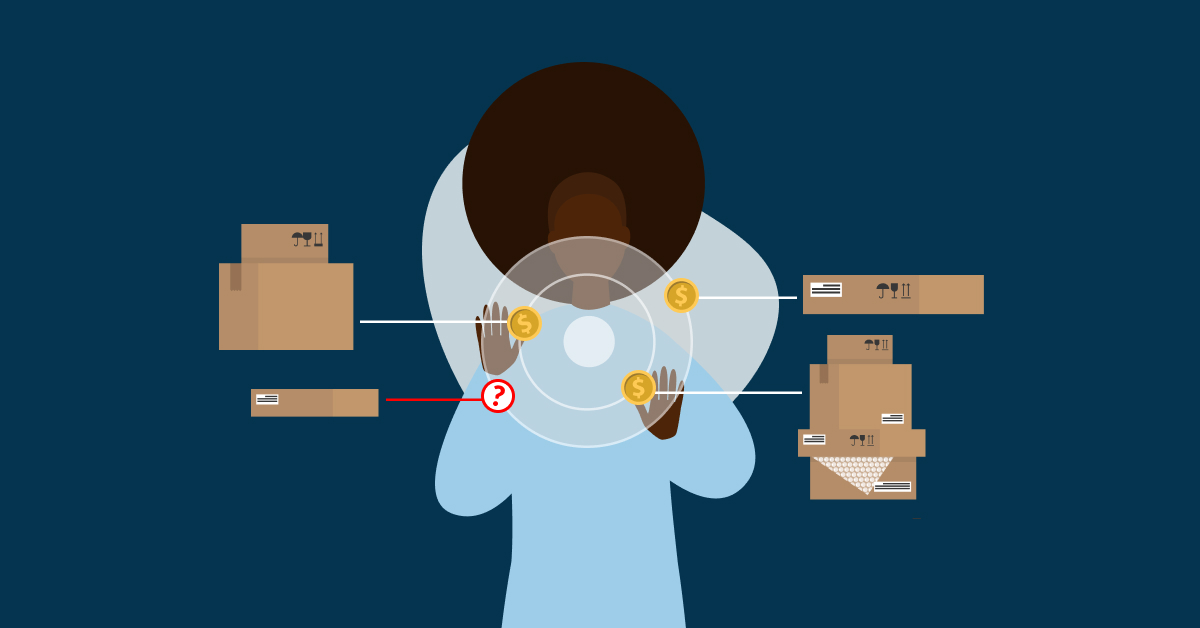
For retailers, cost of goods sold (COGS) is one of the most important metrics to measure, as it’s directly tied to your profit margins, revenue and inventory. If your business doesn’t keep regular track of your COGS, then you risk negatively impacting your store’s bottom line.
Fortunately, retailers have relative control over their COGS; all it takes is a little bit of time and number crunching.
To help set you up for success, this article will dive deep into COGS, how to calculate your cost of goods sold, examples and more.
- What is retail cost of goods sold (COGS)?
- What’s included in retail cost of goods sold?
- How to calculate your cost of goods sold
- Cost of goods sold example
- Inventory accounting methods
- Cost of goods sold vs operating expenses
- COGS vs gross profit: what’s the difference?
- Benefits of calculating cost of goods sold
Free guide: How to manage inventory across multiple stores
Download our free inventory guide to discover the essential stock management best practices every multi-outlet retailer should know.
What is retail cost of goods sold (COGS)?
For a retail business, COGS refers to the direct costs incurred in producing or acquiring goods sold to customers during a specific period.
In a nutshell, it represents the expenses directly associated with producing or purchasing inventory items that are subsequently sold.
Once you’ve calculated your COGS, you can subtract the total COGS value from the revenue generated from the sale of goods to calculate your gross profit. In turn, this provides valuable insights into the profitability and efficiency of your business by determining the direct costs associated with generating revenue from inventory sales.
What’s included in retail cost of goods sold?
While every retail business is different, here are some of the most common costs included in retail COGS.
Cost of inventory
This includes the cost of purchasing or producing the goods sold in your retail store.
It incorporates the cost of raw materials, direct labour, and manufacturing overheads for businesses that produce their inventory. For businesses that purchase inventory, it includes the cost of acquiring goods from suppliers.
Freight and shipping
The expenses incurred to transport goods from your suppliers to your store location are included in COGS. This typically includes shipping fees, freight charges, and customs duties associated with bringing the inventory to your business premises.
Direct labour
If your retail business has to assemble or modify inventory items before sale, such as a bike store, the wages of the employees directly involved in these tasks are included in COGS.
Packaging and handling costs
Expenses related to packaging materials and the labour involved in preparing the goods for sale, such as packaging, labelling, and handling, are also included as part of your COGS.

How to calculate your cost of goods sold
A wide range of factors can affect your cost of goods sold, such as price fluctuations for raw materials and annual wage increases, making it tricky to calculate and forecast your COGS correctly.
To help make your calculations easier, use a simple formula to calculate your COGS.
What is the cost of goods sold formula?
The formula to calculate your COGS is relatively straightforward. It involves summing up the direct costs associated with the production or acquisition of your inventory items sold during a specific period.
The general formula for retail COGS is as follows:
COGS = (Opening Inventory + Purchases and/or Production Costs) – Closing Inventory
Here’s a breakdown of each component:
Opening Inventory
Your opening inventory refers to the value of inventory at the beginning of the period. This includes the cost of inventory items not sold at the end of the previous period.
Purchases or Production Costs
This includes the cost of purchasing new inventory items during the period or the cost of producing the goods, including raw materials, direct labour, and manufacturing overheads.
Closing Inventory
Your closing inventory represents the value of inventory items that remain unsold at the end of the period. It includes the cost of inventory items that were not sold and still held in stock.
By subtracting the closing inventory from the sum of the opening inventory and purchases or production costs, you can determine the total direct costs associated with the goods sold during the period, which is the COGS.
It’s important to note that the specific calculation may vary depending on the accounting methods and inventory valuation methods used by your retail business. The formula we’ve provided above is a general guideline, but it’s advisable to consult with an accountant or financial professional to ensure accurate and compliant calculation of COGS for your specific business.
What do you need to calculate your cost of goods sold?
To help make your calculations easier, ensure you have gathered the following information before you start to work out your COGS.
- Beginning inventory: total cost of all your inventory at the start of the period.
- Cost of purchases: total cost of all the products purchased during the period that are available to sell.
- Cost of labour: total costs for all employees responsible for assembling or preparing the products for sale.
- Cost of resources: any costs associated with making your products.
- Other costs: any costs not previously accounted for, such as shipping and overhead expenses like rent, utilities, hardware, software, etc.
- Ending inventory: total value of all remaining inventory items at the end of the period.
Cost of goods sold example
Let’s say your retail store is calculating its COGS for the first quarter of the financial year: July – September.
Your inventory at the beginning of the quarter, recorded on July 1, is $15,000.
At the end of the quarter, on September 30, your ending inventory is $3,000.
During the quarter, your business made $5,000 worth of purchases.
Calculate your cost of goods sold using the COGS formula: (Beginning Inventory + Purchase) – Ending Inventory.
COGS = ($15,000 + $5,000) – $3,000
COGS = $17,000

Inventory accounting methods
Three different inventory accounting methods will help you calculate your COGS; the weighted average cost method, first in, first out (FIFO) and last in, first out (LIFO).
The one you choose will depend on the specific needs of your business. However, it’s essential to ensure that your chosen method should comply with accounting standards and is consistently applied over time.
Weighted average cost method
The weighted average cost method calculates the average cost of your inventory items. It considers the total cost of goods available for sale divided by the total quantity available for sale.
The formula is as follows:
Weighted Average Cost per Unit = (Total Cost of Goods Available for Sale) / (Total Quantity of Goods Available for Sale)
To calculate your COGS using the weighted average cost method, multiply the weighted average cost per unit by the number of goods sold during the period.
This method ensures that the cost assigned to each unit of inventory is a blend of the costs from different purchase or production transactions. It smooths out fluctuations in the costs of inventory items over time.
First in, first out (FIFO)
The first in, first out (FIFO) method assumes that the first goods purchased or produced are the first goods sold. In other words, the oldest items should be sold first, while the most recent purchases or production costs remain in inventory.
Under FIFO, the cost of goods sold is calculated based on the cost of the oldest inventory available in stock. This method often aligns with the physical flow of goods in many industries and is commonly used when inventory items have a limited shelf life, such as perishable items.
Last in, first out (LIFO)
The last in, first out (LIFO) method is the opposite of FIFO. It assumes that the most recently purchased or produced goods are the first goods sold. It means that the cost of goods sold is based on the cost of the most recently acquired or produced inventory items.
However, LIFO is rarely used in retail as it doesn’t present as accurate valuations as FIFO for most retailers. In fact, the LIFO method is banned in most of the world under the International Financial Reporting Standards.
Cost of goods sold vs operating expenses
One thing to keep top of your mind is that your COGS are tied to sourcing or making your products and bringing them to where you will sell them. They are not part of your operating expenses.
For most retailers, COGS or inventory is typically the largest ongoing expense for the business; all other expenses will fall into operating or capital expenditures.
Operating expenses encompass much more than just the cost of inventory. They can cover everything from paying rent to utilities and payroll. Your COGS is a type of expense that’s tied directly to the product being sold, while other expenses are the cost of running and operating the business.

COGS vs gross profit: what’s the difference?
Understanding the difference between COGS and gross profit is an excellent way for retailers to better gauge how to price their merchandise.
Your COGS is a variable cost showing how much you spent on the merchandise before selling it to your customers.
On the other hand, your gross profit is your revenue – the income you are left with after deducting your total COGS and operating expenses and before you begin to consider tax.
The difference between the retail price customers pay for your products and your COGS is your profit margin. Similarly, the difference between the retail price you receive for a specific product and the COGS is your product margin.
COGS can have a huge impact on a retailer’s profit margins because it is usually the biggest overall expense category for most brands.
By investing the time in optimising your COGS and looking for ways to reduce spending (without impacting product quality), you can have a considerable positive impact on your bottom line.
Benefits of cost of goods sold
From analysing your profitability to remaining tax-compliant, tracking your COGS offers several benefits for your retail business.
Profitability analysis
COGS is a crucial component in calculating gross profit. Therefore, by tracking your COGS, you can accurately assess the profitability of your business. Plus, analysing your COGS also allows you to understand the direct costs associated with the production or acquisition of your products, helping you determine if your pricing strategy is generating adequate profit margins.
Cost control and efficiency
Keeping regular tabs on your COGS enables you to identify cost-saving opportunities and enhance operational efficiency. By analysing the components of your COGS, such as inventory purchases, production costs and supplier relationships, you can identify areas where expenses can be optimised. This can include negotiating better deals with suppliers, streamlining production processes or identifying wasteful practices.
Inventory management
Monitoring your COGS will provide insights into inventory turnover and the value of unsold inventory. By analysing your cost of goods sold and comparing it to your inventory levels, you can assess the efficiency of your inventory management. In turn, this will help you avoid any excessive inventory holding costs, ensuring optimal inventory levels to meet customer demand.
Financial reporting and decision-making
COGS play a critical role in the makeup and accuracy of your financial statements, such as your profit and loss statement and balance sheet. Therefore, accurate COGS tracking ensures the reliability and integrity of financial reporting. It provides financial stakeholders with valuable information about your business’s cost structure and profitability. Plus, this information provides a holistic view of your store’s finances, helping you make informed decisions regarding pricing, product mix, sourcing strategies and resource allocation.
Tax Compliance
Accurate COGS tracking is essential for tax compliance. The cost of goods sold is often deductible for tax purposes, and accurate reporting ensures that tax obligations are calculated correctly. Different inventory accounting methods can have different tax implications, so tracking COGS allows businesses to align their inventory valuation method with tax regulations.
Overall, tracking your COGS provides you with valuable insights into the financial health of your business, helps you make informed decisions, supports cost control efforts, and enables effective pricing and inventory management. For retailers, it’s an essential aspect of financial analysis and strategic planning and will help drive your success and the growth of your business.
Free guide: How to manage inventory across multiple stores
Download our free inventory guide to discover the essential stock management best practices every multi-outlet retailer should know.

News you care about. Tips you can use.
Everything your business needs to grow, delivered straight to your inbox.


